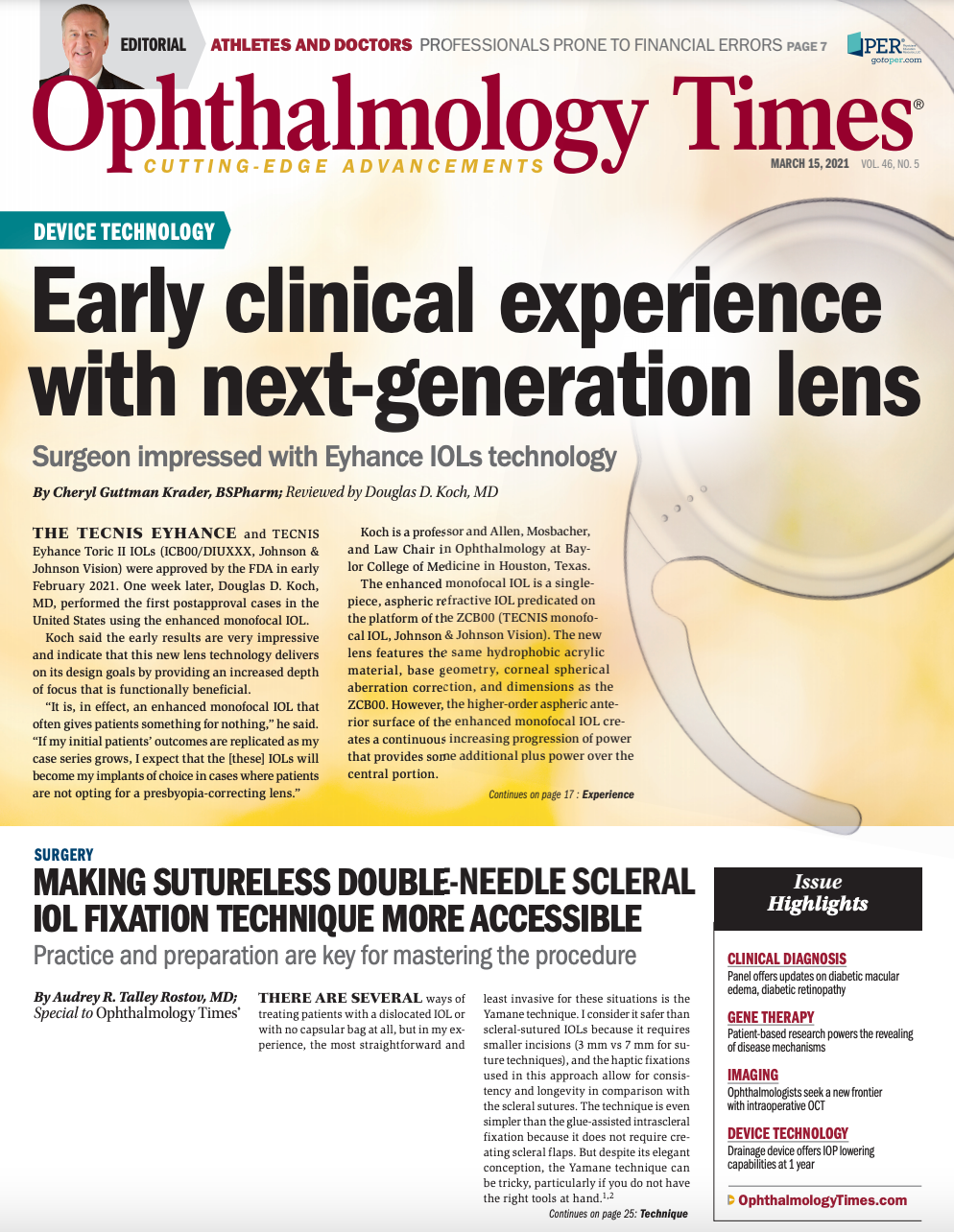Publication
Article
Digital Edition
Early clinical experience with next-generation lens
Author(s):
One surgeon shares the early results of his experience using the new TECNIS Eyhance and TECNIS Eyhance Toric II IOLs in performing the first post-FDA-approved cases in the U.S.


This article was reviewed by Douglas D. Koch, MD
The TECNIS Eyhance and TECNIS Eyhance Toric II IOLs (ICB00/DIUXXX, Johnson & Johnson Vision) were approved by the FDA in early February 2021.
One week later, Douglas D. Koch, MD, performed the first postapproval cases in the United States using the enhanced monofocal IOL.
Koch said the early results are very impressive and indicate that this new lens technology delivers on its design goals by providing an increased depth of focus that is functionally beneficial.
Related: Extended depth-of-field IOLs: Clarifying current nomenclature
“It is, in effect, an enhanced monofocal IOL that often gives patients something for nothing,” he said. “If my initial patients’ outcomes are replicated as my case series grows, I expect that the [these] IOLs will become my implants of choice in cases where patients are not opting for a presbyopia-correcting lens.”
Koch is a professor and Allen, Mosbacher, and Law Chair in Ophthalmology at Baylor College of Medicine in Houston, Texas.
The enhanced monofocal IOL is a single-piece, aspheric refractive IOL predicated on the platform of the ZCB00 (TECNIS monofocal IOL, Johnson & Johnson Vision). The new lens features the same hydrophobic acrylic material, base geometry, corneal spherical aberration correction, and dimensions as the ZCB00.
However, the higher-order aspheric anterior surface of the enhanced monofocal IOL creates a continuous increasing progression of power that provides some additional plus power over the central portion.
Related: IOLs offer great vision, low risk profile for myopia
“The novel optic design of the Eyhance results in improved intermediate vision compared with a standard aspheric monofocal IOL, but [offers] the same performance with respect to distance vision, contrast sensitivity, and risk of photic phenomenon,” Koch said.
Results from a multicenter European prospective randomized study comparing the enhanced monofocal IOL and the ZCB00 IOL demonstrate the performance advantage and safety of the new lens.1
Patients enrolled in the trial were assigned to undergo bilateral implantation with the enhanced monofocal IOL or the standard monofocal lens; 67 patients who received the enhanced monofocal lens and 72 in the standard monofocal IOL group were seen at a 6-month follow-up visit.
Data from ETDRS visual acuity testing showed the enhanced monofocal IOL group achieved significantly better distance-corrected intermediate visual acuity (DCIVA) and uncorrected IVA in both monocular and binocular testing.
Related: Analyzing the visual, non-visual benefits of VLF IOLs
For all end points, there was a 1.0 to 1.1 line difference (Snellen equivalent) between groups favoring the enhanced monofocal IOL.
Mean monocular and binocular distance-corrected VA was 20/20 or better with the enhanced monofocal IOL and noninferior compared with the standard monofocal IOL group.
At 6 months in the enhanced monofocal IOL group, mean binocular DCIVA was 20/25 and mean binocular DCIVA was 20/17. Corresponding with the VA results, binocular defocus curves showed better mean VA from -0.5 through -2.0 D for the enhanced monofocal IOL compared with the standard lens.
Other evaluations showed that the 2 IOLs were associated with similar results in contrast sensitivity testing.
In addition, there were no differences between study groups in reports of photic phenomena collected with a symptoms questionnaire nor in adverse event rates.
Related: Visual outcomes of small-aperture IOL implant in post-laser refractive eyes
Study participants also completed the Catquest-SF9, which is a validated questionnaire for assessing vision for daily life activities. The results showed that significantly more patients who received the enhanced monofocal IOL reported improvement in their ability to see when walking on uneven surfaces, such as cobblestones.
“This is an interesting finding that is consistent with the larger landing zone and better intermediate vision with the lens,” Koch said.
Personal experience
As a member of the Johnson + Johnson Optics Consulting Group, Koch consulted on the design of the enhanced monofocal lens and was familiar with data from its bench testing.
With that information and knowing that the lens was being used successfully by some of his European colleagues who have had access to the technology for 2 years, Koch said he was eager to have the chance to implant it.
Related: Aspheric, aberration-free IOL leverages technology for performance
When Koch saw his first 4 patients back for their postop day 1 visit, uncorrected distance and intermediate vision for 3 of the 4 patients who were targeted for distance were 20/20 and J2, 20/25 and J2, and 20/20 and J5, respectively.
The target refraction for the fourth case was -0.75 D, which was selected to match the fellow eye, and the patient achieved 20/30 uncorrected distance vision and saw J2 for near, he noted.
He added that surgical planning for cases with the Eyhance IOL and implantation is easy.
“The enhanced monofocal IOL has the same A-constant as the ZCB00, and it comes preloaded in the manufacturer’s new injector [Simplicity] that provides the safety and efficiency benefits of a preloaded system, along with very smooth delivery,” Koch said.
Related: Small-aperture single-piece IOL could fill unmet need in patients
Finding its niche
In addition to being a promising alternative for cases where a standard monofocal or toric monofocal IOL would be used, the enhanced monofocal IOL and its toric version are options to use in a monovision approach for patients who want an extended range of vision but who don’t want to receive or are not candidates for a specialty presbyopia-correcting IOL.
In addition, the new lens opens up the possibility of giving an increased depth of focus to patients with ocular comorbidities for whom concerns about reduced contrast sensitivity and visual quality make implantation of an extended depth of focus or trifocal multifocal IOL undesirable.
“I would feel comfortable using the enhanced monofocal IOL in patients with corneal diseases, such as Fuchs' endothelial corneal dystrophy, macular degeneration, or glaucoma,” Koch said.
Related: Assessing aberration of monofocal toric IOL with enhanced optic recovery, alignment
Because of its extended depth of focus, the enhanced IOL also appears to have a broader refractive landing zone compared with a standard monofocal IOL.
For that reason, Koch said it may be useful in patients who are post-LASIK and for whom accurate calculation of IOL power can still be challenging.
“Patients implanted with the enhanced monofocal IOL will still end up with good distance vision if their refraction ends up +0.4 D,” he concluded. “Surgeons should keep in mind, however, that the benefit of this lens is on the myopic side. Therefore, I recommend aiming for plano or -0.1 D rather than a more myopic target.”
Read more by Cheryl Guttman Krader
--
Douglas D. Koch, MD
e:dkoch@bcm.edu
Koch is a consultant to Johnson & Johnson Vision, Alcon, and Carl Zeiss Meditec.
--
Reference
1. Auffarth GU, Gerl M, Tsai L, et al; Quantum Study Group. Clinical evaluation of a new monofocal intraocular lens with enhanced intermediate function in cataract patients. J Cataract Refract Surg. September 3, 2020. doi:10.1097/j.jcrs.0000000000000399

Newsletter
Don’t miss out—get Ophthalmology Times updates on the latest clinical advancements and expert interviews, straight to your inbox.




